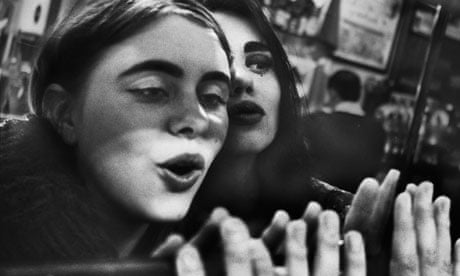Anders Petersen first wandered through Soho back in the 1970s. "It was a different place then," he says, "full of strip clubs and peep shows. Now it is very clean and fashionable, but some traces of the older Soho remain."
A veteran chronicler of the grittier and seedier side of city life, Petersen has made the new Soho look very much like the old one. His new book, called simply Soho, presents glimpses of a place both familiar and strange, recognisable but alien. "It has my signature," he says, laughing, "which is to do with not just my way of looking but my way of approaching a subject and, of course, choosing the light."
When I first met Anders Petersen back in 2006, in his tiny, subterranean studio-cum-office in Stockholm, he described his way of looking as being imbued with "a kind of poetic sadness". You can detect this, too, in his Soho pictures: in the people he chose to photograph, the places he visited on his night-time wanderings and the way he uses graininess and high-contrast tones to accentuate his essentially melancholy vision.
"I am always looking to tell a story," he says, "and the story is always about my journey, the people I encounter, and the places they take me to, both real and imagined. Each picture is a little narrative and a book hopefully becomes a bigger one."
Born in Stockholm in 1944, Petersen studied photography under the great Christer Strömholm at his famous Fotoskolan from 1966 to 1968. Strömholm's advice has guided Petersen's way of working ever since, as he told me in 2006: "Christer said, 'Look for what is important to you, Anders! Be personal! Be humble! Work more! Never be satisfied! Be a thief of ideas, but make them your own!' "
Petersen is best known for his seminal book of intimate reportage, Café Lehmitz, which was first published in 1978 and is recognised as one of the classics of postwar European photography. In it, he captured a time and place now long gone: a bar on Hamburg's Reeperbahn where pimps, prostitutes and their clients mixed with transsexuals and pickpockets. The clientele became his surrogate family and the young Petersen even had a fleeting but intense romance with one of the girls who worked the notorious red-light strip.
Petersen's other books include Fängelse (1984), for which he photographed in a maximum-security prison, and French Kiss (2008) – raw photographs of people who live on the edges of society in the south of France. His collaborative book, From Back Home, with the younger photographer JH Engström, was critically lauded on its publication in 2009. "I use my gut and my intuition rather than my head when I am shooting, " he says. "And I shoot far too much so then I have to use my brain to edit and re-edit. That's the way it has always been with me."
At the request of the Photographers' Gallery in London, Petersen spent just over three weeks shooting in Soho in 2011 for the latest in his City Diaries series. He began in March, when it was "too cold at night" and returned in June, when "it was the perfect mix of shop light and sunlight". He shoots only in black and white and often uses low level flash even during the day to add to the feeling of immediacy and rawness. "I have nothing against colour but, for me, there are so many colours in black and white. You can use your imagination more that way – put your own colours into the pictures."
Petersen has two basic ways of working: the fleeting snapshot, of which he is a master, and the posed portrait. For the latter, he haunted the bars, clubs and cafes of Soho, befriending people he liked the look of and asking them to pose for him. "I never give people money but I offer them a print or a book as payment," he says. "Most people wanted nothing, they were happy to pose and they often had wonderful stories to tell. I found Soho to be a very open and friendly place full of generous people. Really, I learned a lot there."
He shot in various famous and infamous Soho haunts, from the French House to Blacks private members' club, as well as in several burlesque bars and dingy upstairs rooms where "models" entertain their clientele. Sometimes, he went to peoples' homes or took them back to his hotel room. Often the results are intimate and edgy, as is his style. One young woman smokes a cigarette held between her toes; another blow-dries her hair, topless, with a very phallic looking hairdryer. There were many tattooed bodies, several exhibitionists, some darkly beautiful urban landscapes and a series of wonderful, almost-romantic portraits of the young and the beautiful going about their daily business.
It is, he says, Soho as a kind of impressionistic self-portrait. "My longings and desires are in there, too," he says, "and I felt at home in the places I visited. In the heart of many big cities, there are now only young people. I think this is sad. It is like the old have been banished. I did not feel that so much in Soho. It has changed, for sure, but there is still a big mix of people and many special characters, old and young. For me, Soho is something special."

Comments (…)
Sign in or create your Guardian account to join the discussion